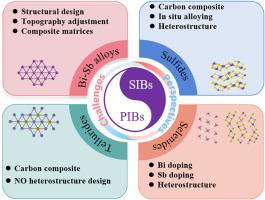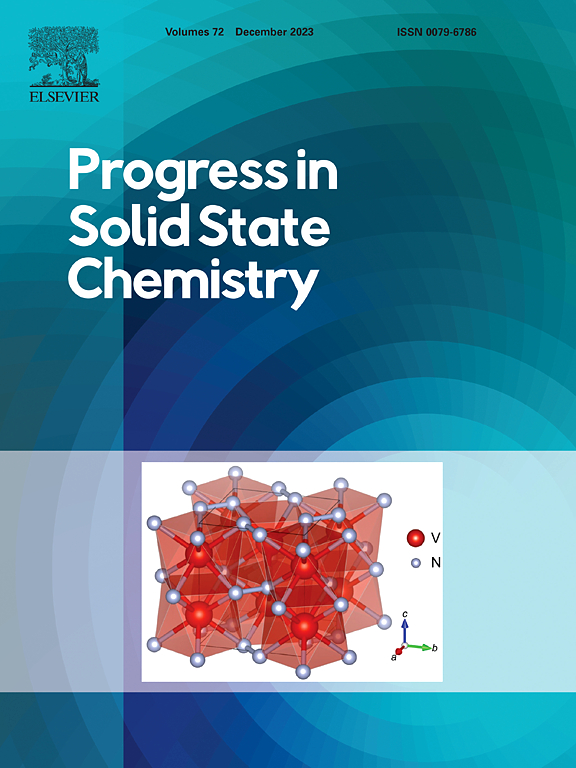Insight into Bi-Sb alloys and their chalcogenide compounds for sodium/potassium ion battery (SIB/PIB) anodes
IF 10.5
2区 化学
Q1 CHEMISTRY, INORGANIC & NUCLEAR
引用次数: 0
Abstract
Sodium/potassium ion batteries (SIBs/PIBs), emerging as promising alternatives to lithium-ion batteries (LIBs), show great potential in large-scale electrical energy storage systems owing to their abundant reserves, potential cost advantages, and low standard redox potentials. In recent years, Bi-Sb alloys and their chalcogenide compounds (sulfides, selenides, and tellurides) have garnered significant attention due to their unique bimetallic synergistic effects and tunable energy storage mechanisms. This paper reviews the recent progress in Bi-Sb alloys and their chalcogenide compounds as anode materials for SIBs and PIBs. Highlighting the synergistic effects of Bi-Sb systems, the study emphasizes their high theoretical capacity, reduced volume expansion, and enhanced structural stability compared to monometallic counterparts. Key strategies such as nano-structuring (e.g., nanoporous and 2D layered architectures), composite engineering (e.g., carbon-based matrices), and heterostructure design are discussed to address challenges like electrode pulverization. The electrochemical mechanisms, including multi-step alloying and conversion reactions, are analyzed to elucidate performance enhancements in terms of cycling stability, rate capability, and capacity retention. Specifically, the paper examines the structural properties, modification strategies, and performance optimization mechanisms of these materials, and identifies key pathways for their engineering applications, aiming to provide theoretical support and technological references for designing high-capacity anode materials for SIBs/PIBs. Additionally, critical issues, challenges, and prospects for further development are suggested. This work provides critical insights into material design principles and offers pathways for developing next-generation, cost-effective energy storage technologies.

钠/钾离子电池(SIB/PIB)阳极用Bi-Sb合金及其硫系化合物的研究
钠/钾离子电池(SIBs/PIBs)作为锂离子电池(LIBs)的潜在替代品,由于其储量丰富、潜在的成本优势和低标准氧化还原电位,在大规模电能存储系统中显示出巨大的潜力。近年来,铋锑合金及其硫族化合物(硫化物、硒化物和碲化物)因其独特的双金属协同效应和可调的储能机制而受到广泛关注。本文综述了近年来铋锑合金及其硫族化合物作为SIBs和PIBs阳极材料的研究进展。该研究强调了Bi-Sb体系的协同效应,与单金属体系相比,它们具有更高的理论容量、更小的体积膨胀和更高的结构稳定性。讨论了纳米结构(如纳米多孔和二维层状结构)、复合材料工程(如碳基矩阵)和异质结构设计等关键策略,以解决电极粉化等挑战。分析了电化学机制,包括多步合金化和转化反应,以阐明在循环稳定性,速率能力和容量保持方面的性能增强。具体而言,本文研究了这些材料的结构特性、改性策略和性能优化机制,并确定了其工程应用的关键途径,旨在为sib / pib高容量阳极材料的设计提供理论支持和技术参考。此外,还提出了关键问题、挑战和进一步发展的前景。这项工作为材料设计原理提供了重要的见解,并为开发下一代具有成本效益的储能技术提供了途径。
本文章由计算机程序翻译,如有差异,请以英文原文为准。
求助全文
约1分钟内获得全文
求助全文
来源期刊

Progress in Solid State Chemistry
化学-无机化学与核化学
CiteScore
14.10
自引率
3.30%
发文量
12
期刊介绍:
Progress in Solid State Chemistry offers critical reviews and specialized articles written by leading experts in the field, providing a comprehensive view of solid-state chemistry. It addresses the challenge of dispersed literature by offering up-to-date assessments of research progress and recent developments. Emphasis is placed on the relationship between physical properties and structural chemistry, particularly imperfections like vacancies and dislocations. The reviews published in Progress in Solid State Chemistry emphasize critical evaluation of the field, along with indications of current problems and future directions. Papers are not intended to be bibliographic in nature but rather to inform a broad range of readers in an inherently multidisciplinary field by providing expert treatises oriented both towards specialists in different areas of the solid state and towards nonspecialists. The authorship is international, and the subject matter will be of interest to chemists, materials scientists, physicists, metallurgists, crystallographers, ceramists, and engineers interested in the solid state.
 求助内容:
求助内容: 应助结果提醒方式:
应助结果提醒方式:


